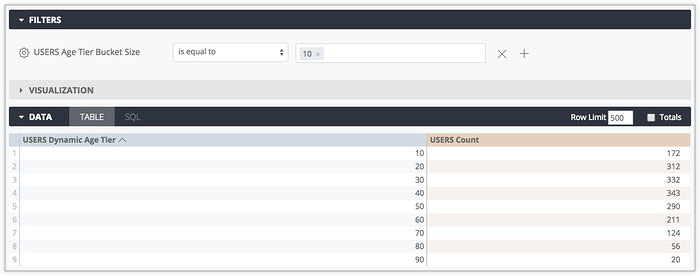Tiers can be a great way to bucket values. However, with LookML type: tier dimensions, those buckets are predefined and static. Sometimes you may want to create a dynamic tier that lets users change the bucket size. You can do this in Looker using filter-only fields (called parameter parameters) in conjunction with a templating language (called Liquid).
You can also use custom binning to create dynamic tiers natively in Explores when you have permission to create or edit custom fields.
To create a dynamic tier:
-
Create a parameter of
type: numberto serve as the frontend filter field where the user can enter the numerical bucket size they would like. -
Create a dimension that references the parameter value with the Liquid variable
{% parameter parameter_name %}. This dimension determines the various buckets and will dynamically change the bucket size to the value entered by the user in the frontend filter field (theparameterparameter).
For example, a developer creates a dynamic age tier that lets users bucket age values by custom ranges:
The SQL syntax for the following example may need to be adapted to suit your database dialect.
parameter: age_tier_bucket_size {
type: number
}
dimension: dynamic_age_tier {
type: number
sql: TRUNCATE(${TABLE}.age / {% parameter age_tier_bucket_size %}, 0)
* {% parameter age_tier_bucket_size %} ;;
}
A user can now choose tier values for the Age column in an Explore. For example, a user might want to see ages grouped into 10-year buckets and so enter the value 10 in the Age Tier Bucket Size filter:

The SQL expression in the dynamic_age_tier dimension divides an age value from the underlying ${TABLE}.age column — for example, 25 — by the parameter value of 10, resulting in 2.5. The value 2.5 is truncated to 2 by the TRUNCATE function and is multiplied by the parameter value 10, resulting in 20. 20 becomes the bucket; any age value between 20 and 29 is included in the 20 bucket.
